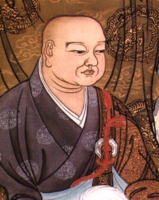Difference between revisions of "Keizan"
| Line 7: | Line 7: | ||
|bio=Keizan Jōkin (Japanese: 瑩山紹瑾, 1268–1325), also known as Taiso Jōsai Daishi, is considered to be the second great founder of the Sōtō school of Zen in Japan. While Dōgen, as founder of Japanese Sōtō, is known as Highest Patriarch (高祖, kōso), Keizan is often referred to as Great Patriarch (太祖, taiso). | |bio=Keizan Jōkin (Japanese: 瑩山紹瑾, 1268–1325), also known as Taiso Jōsai Daishi, is considered to be the second great founder of the Sōtō school of Zen in Japan. While Dōgen, as founder of Japanese Sōtō, is known as Highest Patriarch (高祖, kōso), Keizan is often referred to as Great Patriarch (太祖, taiso). | ||
| − | Keizan and his disciples are credited with beginning the spread of Sōtō Zen throughout Japan, away from the cloistered monastic practice characteristic of Dōgen's Eihei-ji, and towards a more popular religion that appealed to all levels of Japanese society. Keizan founded several temples throughout his lifetime, most notably Yōkō-ji and Daihonzan Sōji-ji (founded on the Noto Peninsula and moved to Tsurumi-ku, Yokohama in 1911). Today Sōji-ji and Eihei-ji stand together as the two principal Sōtō Zen training centers in Japan. ([https://en.wikipedia.org/wiki/Keizan Source Accessed June 29, 2021]) | + | Keizan and his disciples are credited with beginning the spread of Sōtō Zen throughout Japan, away from the cloistered monastic practice characteristic of Dōgen's Eihei-ji, and towards a more popular religion that appealed to all levels of Japanese society. Keizan founded several temples throughout his lifetime, most notably Yōkō-ji and Daihonzan Sōji-ji (founded on the Noto Peninsula and moved to Tsurumi-ku, Yokohama in 1911). Today Sōji-ji and Eihei-ji stand together as the two principal Sōtō Zen training centers in Japan. |
| + | |||
| + | Keizan was the author of a number of works including the "Zazen Yōjinki" and, most famously, the Denkōroku "Transmission of the Light", which is a series of fifty-one sermons which details linearly the Sōtō lineage from Gautama Buddha through the Indian Patriarchs, from Bodhidharma and the Chinese Patriarchs, and finally the Japanese patriarchs Dōgen and his immediate successor at Eihei-ji, Ejō. ([https://en.wikipedia.org/wiki/Keizan Source Accessed June 29, 2021]) | ||
|PersonType=Classical Japanese Authors | |PersonType=Classical Japanese Authors | ||
| + | |images=File:Keizan Sotozen.png | ||
|AltNamesOther=Taiso Jōsai Daishi | |AltNamesOther=Taiso Jōsai Daishi | ||
|YearBirth=1268 | |YearBirth=1268 | ||
Revision as of 19:24, 28 June 2021
| English Phonetics | Keizan Jōkin |
|---|---|
| Sort Name | Jōkin, Keizan |
| Japanese Script | 瑩山紹瑾 |
- Taiso Jōsai Daishi
| Birth: | 1268 |
|---|---|
| Death: | 1325 |
Tibetan calendar dates
- Religious Affiliation
- Sōtō Zen
Biographical Information
Keizan Jōkin (Japanese: 瑩山紹瑾, 1268–1325), also known as Taiso Jōsai Daishi, is considered to be the second great founder of the Sōtō school of Zen in Japan. While Dōgen, as founder of Japanese Sōtō, is known as Highest Patriarch (高祖, kōso), Keizan is often referred to as Great Patriarch (太祖, taiso).
Keizan and his disciples are credited with beginning the spread of Sōtō Zen throughout Japan, away from the cloistered monastic practice characteristic of Dōgen's Eihei-ji, and towards a more popular religion that appealed to all levels of Japanese society. Keizan founded several temples throughout his lifetime, most notably Yōkō-ji and Daihonzan Sōji-ji (founded on the Noto Peninsula and moved to Tsurumi-ku, Yokohama in 1911). Today Sōji-ji and Eihei-ji stand together as the two principal Sōtō Zen training centers in Japan.
Keizan was the author of a number of works including the "Zazen Yōjinki" and, most famously, the Denkōroku "Transmission of the Light", which is a series of fifty-one sermons which details linearly the Sōtō lineage from Gautama Buddha through the Indian Patriarchs, from Bodhidharma and the Chinese Patriarchs, and finally the Japanese patriarchs Dōgen and his immediate successor at Eihei-ji, Ejō. (Source Accessed June 29, 2021)
- Wiki Pages
